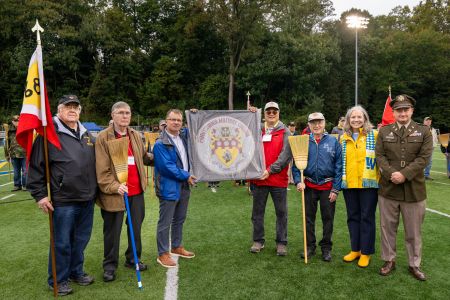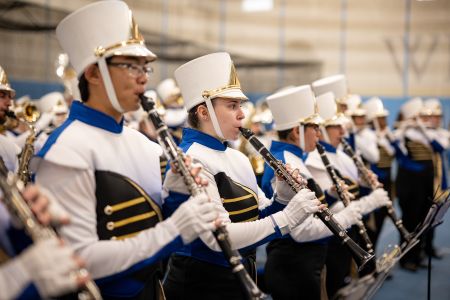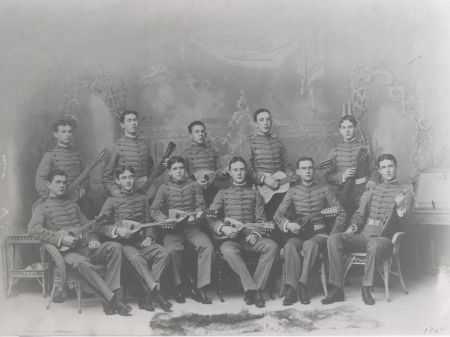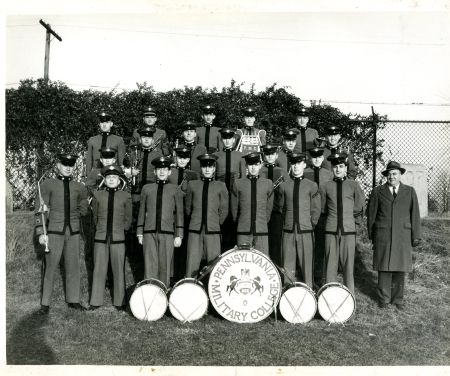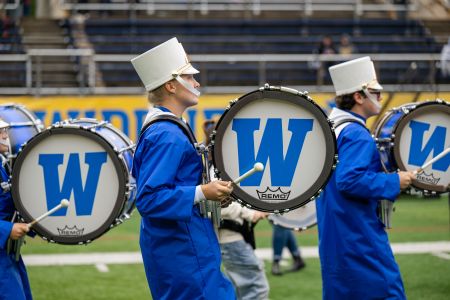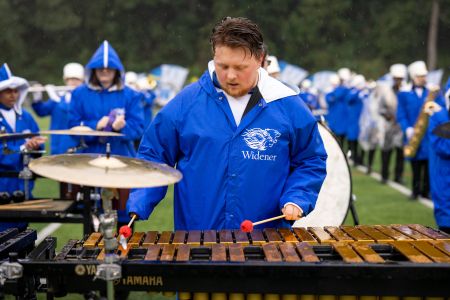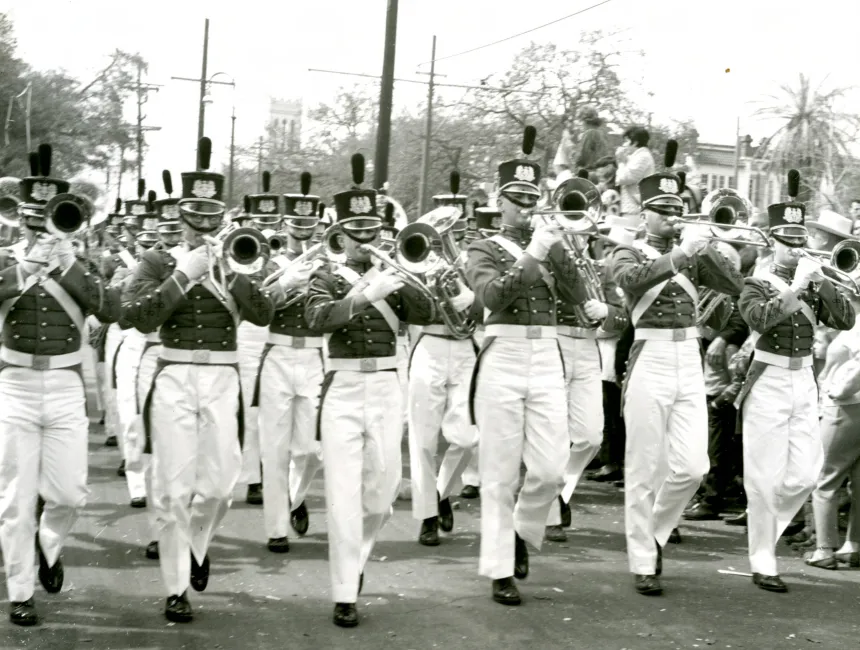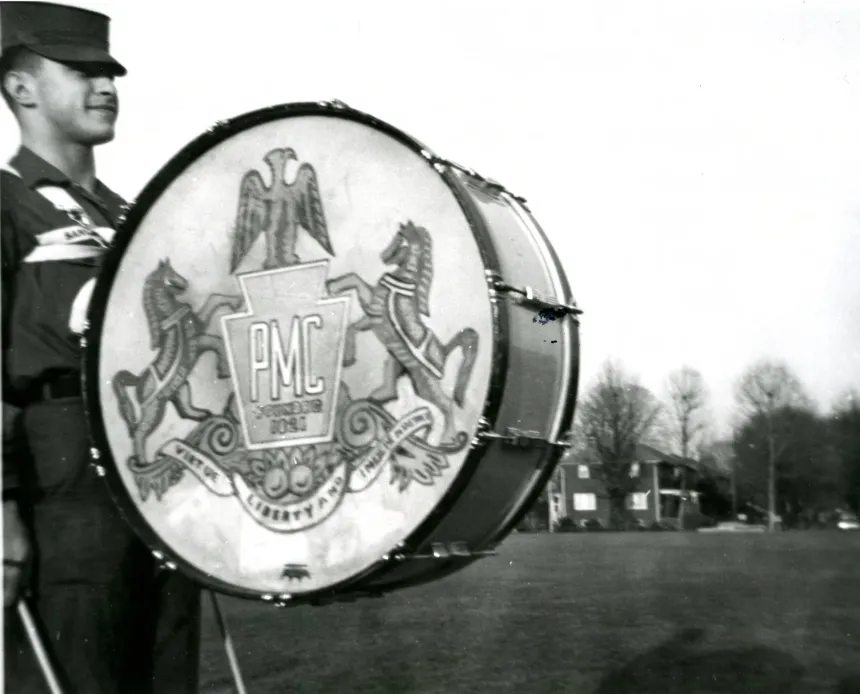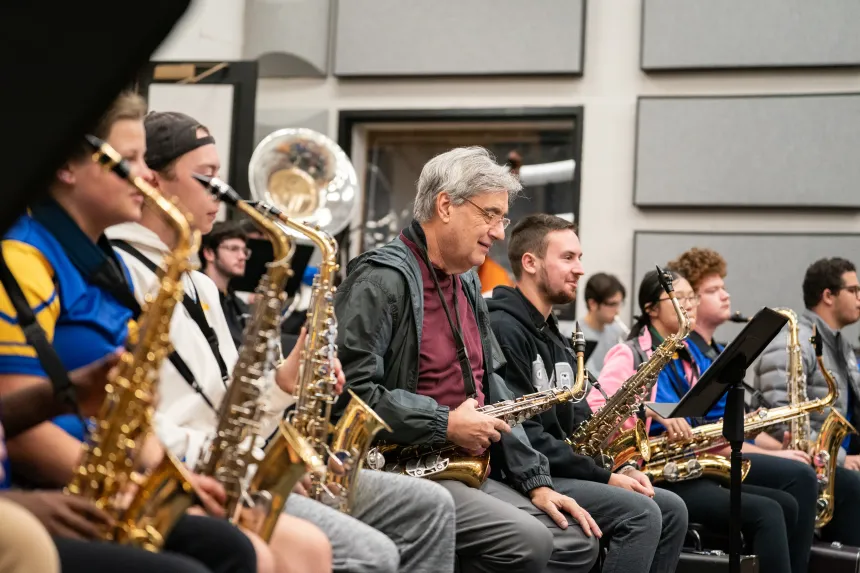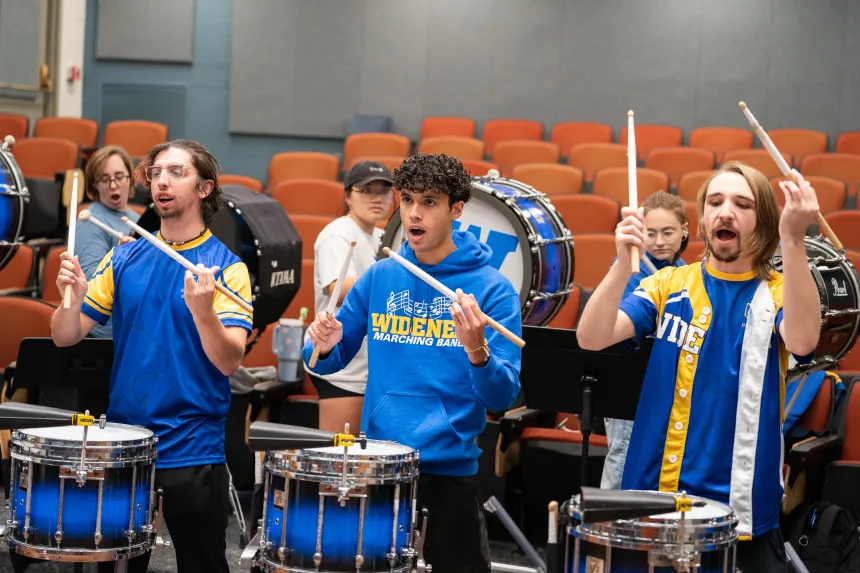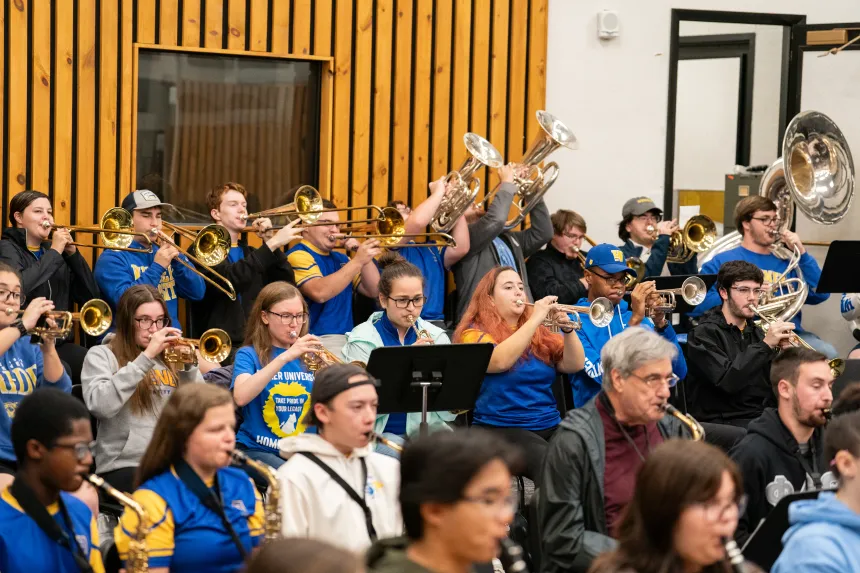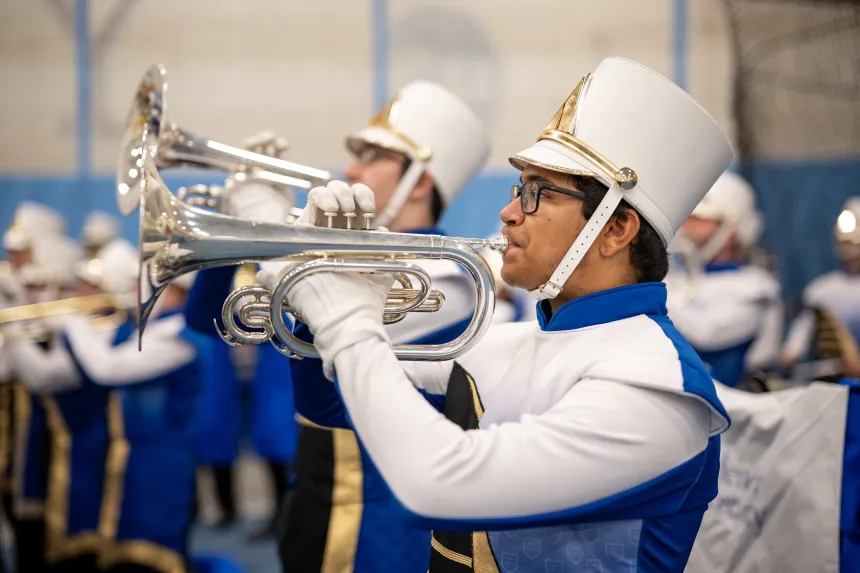Getting the Band Back Together
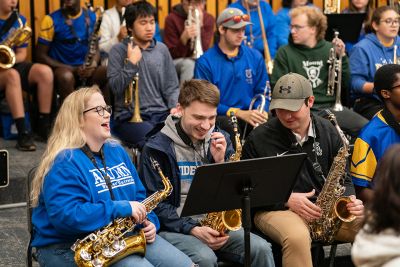
For the first time in school history, an alumni band took to the field at halftime of the Homecoming football game.
It was comprised of current Widener Marching Band members, along with more than 25 school graduates representing different eras and iterations of musical groups that have existed on campus.
Together, the musicians belted out a medley of songs, including the Widener Fight Song Fanfare and Otis Redding’s “I Can’t Turn You Loose,” which played Widener football players onto the field in the 1970s and ‘80s.
Just prior to the game, the Pennsylvania Military College (PMC) Band Alumni Committee presented the university with a framed drumhead donated by John Chiartas ‘75 and his wife Lynn ‘76. This was the last drumhead of the PMC Band, which dissolved in 1972 when PMC became Widener. The drumhead will be on display at Kapelski Learning Center, home of the Widener music department.
“We wanted to give the Widener Band a piece of PMC’s history to develop their own history, and to help boost enthusiasm for future marching band history,” said John Chiartas, who had played that very drumhead and was the PMC Band’s last bass drummer, graduating as a Widener student.
The PMC Band Alumni Committee also made a monetary donation to help fund the Widener Marching Band in developing their own unique display at Kapelski. “It was our pleasure to help ‘seed’ this project for the Widener Band, and we look forward to seeing their finished product,” said Andy Fraser ’67, committee chair.
The Homecoming performance and donation are helping to bridge the past and present together. And it was a fitting way to celebrate the current Widener Marching Band’s five-year anniversary.
First fielded in 2018, and the first under the Widener name, the band and color guard have grown in both size and spectacle in the years since. The band now partners with the cheer and Pride Pack Dance teams to wow fans at football games and audiences at area high schools and festivals.
“The marching band has brought a collaborative spirit to the university,” said Iain Moyer, director of athletic bands. “It brings a soundtrack to life. Pep bands are great, but marching band is audio and visual. There is something intrinsically fascinating watching lots of people doing the same thing. You can hear us and see us.”
Band of Brothers
While the Widener Marching Band is celebrating just five years, band history at the school stretches back nearly 160 years.
The first known drum and bugle unit began in 1864 at what was then Pennsylvania Military Academy. The unit played military marches, performed in parades, drills, and field maneuvers, and guided the cadets through their day; buglers played Reveille at dawn and Taps in the evening, while drummers marched cadets to meals.
In 1922, famed composer and conductor John Philip Sousa created “The Dauntless Battalion March,” dedicating it to then-PMC president General Charles E. Hyatt, the faculty, and the PMC cadets.
The first PMC field band appeared in 1935 and continued alongside the drum and bugle corps until they combined in the 1950s. The PMC Band played for Honor Guards, parades, at football games, the annual Mother’s Day parade, and other special occasions.
The band enjoyed great success off campus, as well, with cadets marching in the New York City St. Patrick’s Day Parade, the Cherry Blossom Festival in Washington, D.C., the New Orleans Mardi Gras Parade, the Little Army-Navy Game in Atlantic City, and other venues. In the 1960s, the band captured top honors at the National ROTC Band Competition at the New York World’s Fair.
A strong bond and sense of camaraderie existed amongst the PMC Band members.
“All of these years later, we’re still brothers,” said Chiartas.
The band’s days came to an end in 1972 when the institution shifted to a traditional, non-military school – yet still with an ROTC program – and became Widener College.
“Sure, it tugged at our hearts,” said Stu Perlmutter ’70, who, as a bugler and trumpet player, had performed 6:30 a.m. Reveille calls when the band existed. Perlmutter also played Taps at military funerals of his fellow cadets killed in the Vietnam War and continues to play Taps at funerals today, as well as at Homecoming ceremonies, for departed alumni.
Back on the Field
Although the marching band was gone, the campus maintained a thriving music presence. Under the direction of John Vanore, the military marches gave way to concert-based jazz and wind ensembles. There was also a pep band, which played in the stands at football games.
But there was a desire for something more, propelled in large part by then-university President Jim Harris, who brought Moyer on board. After a few years of organization and recruitment of students, the Widener Marching Band officially debuted in September 2018.
Serena Turco ’19 had just started her final year at Widener that fall. She joined the new band’s ranks, but “it didn’t feel like our inaugural year,” she recalls. “There were a lot of freshmen coming straight out of high school marching bands, so everybody was ready to go.”
Nick Lubeck ’22 was one of the freshman band members. The trumpet player describes the atmosphere as “high energy.”
“It’s a fun college band. We’re there to have fun,” said the robotics engineering alumnus, who performed as part of the alumni band during Homecoming this year. “I met some of my closest friends at Widener through band.”
The current marching band is a modern ensemble with a modern repertoire, but it continues to honor its roots. Its blue and gold uniforms, topped with blue plumed shakos, are intended to be traditional and contemporary – partially an ode to the PMC legacy and reminiscent of the cadet dress of decades ago, and partially a modern pageantry-style uniform worn by marching ensembles today.
The band has also tapped into prior repertoires, playing PMC #3, a traditional drum cadence previously performed by the PMC drum section.
“And we connect most with the PMC tradition at Homecoming with the drumline,” said Moyer, referring to the band drumline leading the annual broom drill.
From football games to Convocation, the Widener Marching Band has certainly made its presence on campus known. And it has given student musicians a chance to continue playing the instrument they love.
That was the main appeal for nursing major Alexa Santos ’25, the current drum major. A clarinet and alto saxophone player, Santos had been part of marching band in high school and wanted to keep going.
It’s the best decision I’ve made during my time at Widener. Nursing is really stressful so having a place familiar to me, and something I’m passionate about, is very helpful. A lot of my friends are from band, so it’s a great way to meet people, and I see that passion for music still there for them, too." — Alexa Santos '25
Santos said that the band also helps cultivate community, and “you can tell that we love what we do.” What’s more, she said, is that audiences also enjoy it. “People appreciate the time we put into our music and marching.”
The Widener Marching Band has faced challenges in its short lifespan—most notably COVID. During the height of the pandemic, with the university operating remotely and large gatherings on hold, Moyer and his staff had to get creative to find ways to keep band members together and engaged, and still have that musical outlet they craved.
In addition to individual and group lessons over Zoom, band members participated in special projects, including a hybrid video version of the Widener alma mater, and the drumline performing PMC #3 in the Bown Garden behind Old Main.
“It was challenging but also rewarding,” recalls Moyer. “I thought ‘if we can keep this thing together, we’ll get back to campus and back on the field.’”
Lubeck said COVID offered a silver-lining for the nascent band.
“It was a small step back, but at the same time it gave us a chance to get more organized,” he said. “It allowed the band to develop more, and when we came back it was like we had hit the restart button.”
When campus reopened, and life returned to a more normal pace, the Marching Band picked up the baton and led the charge, welcoming fans back to the stands and galvanizing new students during Academic Convocation.
Marching Forward
The band has come a long way from its drum and bugle days of the Civil War era. Sousa marches have been replaced with pop standards from artists like Queen and Katy Perry, and strict marching formations have given way to more pomp and pageantry.
With nearly 100 members today, the band grows more and more integrated into campus life with each passing year, finding new places to play and ways to unite the community.
“There’s something about marching band. You totally feel connected,” said Turco.
Seeing its continued success brings smiles to the faces of band alumni of all eras.
“A marching band is not something that every university has, especially small ones,” said Lubeck. “It’s great seeing where it is now.”
Special thanks to the PMC Band Alumni Committee:
Jerry McAteer '65
Andy Fraser '67
Jim Love '68
Stu Perlmutter '70
Greg Haugens '72
John Chiartas '75
The PMC Museum located in Alumni Auditorium contains a comprehensive PMC Band exhibit, and the PMC Museum’s YouTube channel features an extensive collection of videos featuring PMC Band music.

